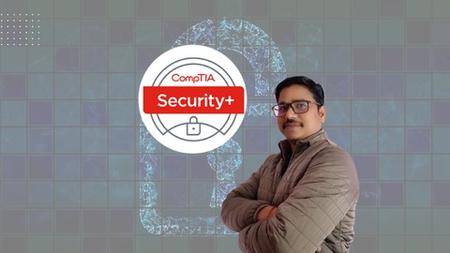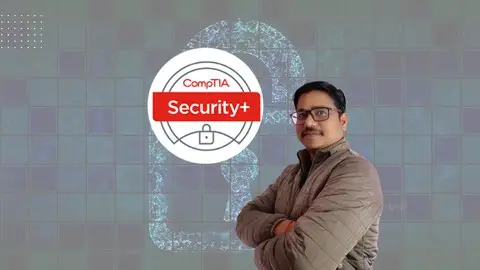Comptia Security+ (Sy0-701) Certification Training
Published 3/2024
MP4 | Video: h264, 1920x1080 | Audio: AAC, 44.1 KHz
Language: English | Size: 5.79 GB | Duration: 14h 46m
Published 3/2024
MP4 | Video: h264, 1920x1080 | Audio: AAC, 44.1 KHz
Language: English | Size: 5.79 GB | Duration: 14h 46m
Mastering Cybersecurity Essentials for CompTIA Security+ Certification
What you'll learn
Understanding foundational cybersecurity concepts.
Identifying various types of security threats and attacks.
Implementing cryptography techniques for data protection.
Developing skills in risk management and incident response.
Securing network infrastructure and protocols.
Requirements
No specific prerequisites are required for the CompTIA Security+ course. Beginners are welcome. Basic computer skills recommended. Its better you have completed CompTIA A+ and N+ course.
Description
Course Description:Are you ready to take your cybersecurity skills to the next level? Welcome to the Comprehensive CompTIA Security+ Certification Training course!In today's digital age, cybersecurity is more critical than ever. Whether you're an IT professional looking to enhance your security knowledge or a beginner interested in starting a career in cybersecurity, this course is designed to equip you with the essential skills and knowledge needed to pass the CompTIA Security+ certification exam.This comprehensive course covers everything you need to know to become a certified cybersecurity professional. From understanding core security principles to implementing advanced security measures, you'll learn from industry experts with real-world experience.What You'll Learn:Master the fundamentals of cybersecurity, including confidentiality, integrity, and availability (CIA triad).Explore common cyber threats, attack vectors, and vulnerabilities.Gain hands-on experience with network security, cryptography, and secure communication protocols.Learn about identity and access management, authentication methods, and user access controls.Discover security technologies and tools used to detect, prevent, and respond to cyber threats.Understand incident response and recovery procedures, business continuity planning, and disaster recovery strategies.Dive into security policies, compliance requirements, and governance frameworks.Develop ethical hacking skills and learn penetration testing methodologies.Stay updated with the latest cybersecurity best practices and industry trends.Why Choose This Course?Expert Instruction: Learn from certified cybersecurity professionals with years of industry experience.Practical Training: Gain hands-on experience with real-world scenarios and practical exercises.Exam Preparation: Prepare effectively for the CompTIA Security+ certification exam with comprehensive exam coverage and practice tests.Career Advancement: Enhance your cybersecurity skills and boost your career prospects in the IT industry.Community Support: Join a supportive learning community and network with peers and experts in the field.Enroll now and start your journey toward becoming a certified CompTIA Security+ professional! Let's secure the digital world together!
Overview
Section 1: Introduction
Lecture 1 Introduction
Section 2: Summarize Fundamental Security Concepts
Lecture 2 Elements of Information Security
Lecture 3 Cyber Security Framework
Lecture 4 Gap Analysis and Access Control
Lecture 5 Security Control Categories
Lecture 6 Security Control Functional Types
Lecture 7 Information's Rolls and Responsibility and Units
Section 3: Compare Threat Types
Lecture 8 Introduction : Compare Threat Types
Lecture 9 Vulnerability, Threat, and Risk
Lecture 10 Attributes and Motivations of Threat Actors
Lecture 11 Different types of Threat actors and hacktivist
Lecture 12 Attack Surface and Vulnerable Software Vectors
Lecture 13 Network and Lure based attack
Lecture 14 Supply Chain Attack Surface
Lecture 15 Social Engineering - Impersonation and Pretexting
Lecture 16 Phishing, pharming and Typo squatting
Lecture 17 Compromise business Emails
Section 4: Explain Cryptographic Solutions
Lecture 18 Introduction of Cryptographic Solutions
Lecture 19 Cryptographic Concepts
Lecture 20 Symmetric Encryption
Lecture 21 Key Length
Lecture 22 Asymmetric Encryption
Lecture 23 Hashing
Lecture 24 Digital Signature
Lecture 25 Certificate Authorities
Lecture 26 Digital Certificate and Root of Trust
Lecture 27 Certificate Signing Requests and CN
Lecture 28 Certificate Revocation and Key Management
Lecture 29 Crypto processors and Secure Enclaves
Lecture 30 Key Escrow
Lecture 31 Encryption Supporting Confidentiality file, disk and database encryption
Lecture 32 Transport Encryption and Key exchange
Lecture 33 Perfect Forward Secrecy
Lecture 34 Salting, key stretching and Block Chain
Section 5: Implement Identity and Access Management
Lecture 35 Authentication Design
Lecture 36 Password concepts and password manager
Lecture 37 Multifactor and Biometric Authentication
Lecture 38 Type of Authentication Hard, soft and password less
Lecture 39 DAC and MAC
Lecture 40 Role-based and Attribute-Based Access Control
Lecture 41 Rule-Based Access Control
Lecture 42 Least privilege an user account provisioning
Lecture 43 Account Attributes and Access and restriction policies
Lecture 44 Local, Network, and Remote Authentication
Lecture 45 Directory Service and Single Sign-on Authentication
Lecture 46 Federation or Shared sign-on authentication
Lecture 47 SAML and OAuth
Section 6: Secure Enterprise Network Architecture
Lecture 48 Introduction : Maintain Enterprise Campus Network Architecture
Lecture 49 Architecture and Infrastructure concept
Lecture 50 Network Infrastructure
Lecture 51 Switching and Routing Infrastructure Considerations
Lecture 52 Security Zones and Attack Surface
Lecture 53 Port Security and Physical Isolation
Lecture 54 Architecture Considerations
Lecture 55 Device Placements and Attributes
Lecture 56 Layer 4 and Layer 7 Firewall
Lecture 57 Proxy Server and IDS
Lecture 58 NGF, UTM and Load Balancer
Lecture 59 VPN Remote Access Architecture
Lecture 60 IPSec and TLS Tunneling
Lecture 61 Internet Key Exchange in VPN
Lecture 62 RDP and Secure Shell
Lecture 63 Out of band Management and Jump Servers
Section 7: Secure Cloud Network Architecture
Lecture 64 Cloud deployment Models based on Ownership
Lecture 65 Security Considerations on Cloud Infra
Lecture 66 6a-3 Types of Coluds based on services
Lecture 67 Responsibility Matrix Cloud Service Provider and Costumer
Lecture 68 Centralized and decentralized de-computing
Lecture 69 Resilient Architecture Concepts
Lecture 70 Virtualization and Cloud Technology
Lecture 71 Software Defined Networking
Lecture 72 Cloud Features and Security Consideration
Lecture 73 Embedded System and Industrial Control Systems
Lecture 74 Introduction of IOT Devices and its security
Lecture 75 Deperimeterization and Zero Trust
Lecture 76 Essential Components of a Zero Trust Architecture and Security
Section 8: Evaluate Network Security Capabilities
Lecture 77 Benchmarks and Secure Configuration Guides
Lecture 78 Switches and Routers Security baseline
Lecture 79 Server Hardware and Operating Systems
Lecture 80 Wireless Network Installation Considerations
Lecture 81 Access Control Lists
Lecture 82 Intrusion Detection and Prevention Systems
Lecture 83 Web Filtering
Section 9: Assess Endpoint Security Capabilities
Lecture 84 Introduction of End point Security
Lecture 85 Endpoint Security and Protection
Lecture 86 Advanced Endpoint Protection
Lecture 87 Endpoint Configuration for enhancing Security
Lecture 88 Hardening End and Specialized Devices
Lecture 89 Mobile Hardening Techniques
Lecture 90 Full Device Encryption and External Media
Lecture 91 Different location Services in Mobile device
Lecture 92 Different Connection Methods in Mobile Device
Section 10: Enhance Application Security Capabilities
Lecture 93 Understanding of Secure Protocols
Lecture 94 Transport Layer Security
Lecture 95 Secure Directory Services
Lecture 96 Simple Network Management Protocol Security
Lecture 97 File Transfer Services
Lecture 98 Email Services
Lecture 99 Email Security
Lecture 100 Email Data lose prevention
Lecture 101 DNS Security
Section 11: Explain Incident Response and Monitoring Concepts
Lecture 102 Digital forensics Due Process and Legal Hold
Lecture 103 Data Acquisition from System Memory and Hard disk
Lecture 104 Preservation and Reporting in Digital Forensics
Lecture 105 Data Sources, Dashboards, and Reports
Lecture 106 Log Data
Lecture 107 Host Operating System Logs
Lecture 108 Application, Endpoint, and Network Data sources
Lecture 109 Packet Capture and Metadata
Lecture 110 Security Information And Event Management
Lecture 111 Alerting and Monitoring Activities
Lecture 112 Alert tuning and Monitoring Infrastructure
Lecture 113 Monitoring System and Applications and Benchmark
Section 12: Analyze Indicators of Malicious Activity
Lecture 114 Malware Classification
Lecture 115 Computer Viruses
Lecture 116 Computer Worms and Fileless Malware
Lecture 117 Spyware Adware and keyloggers
Lecture 118 Backdoors, RAT and rootkits
Lecture 119 Ransomware, Crypto-malware, and Logic Bombs
Lecture 120 TTPs and Malicious Activity Indicators
Lecture 121 Physical and Network Attacks
Lecture 122 Distributed Denial of Service Attacks
Lecture 123 On Path and DNS attack
Lecture 124 Wireless Attacks
Lecture 125 Password Credential Replay Attacks
Lecture 126 Cryptographic Attacks and Malicious Code indicators
Lecture 127 Application Attacks
Lecture 128 Replay and Forgery Attacks
Lecture 129 Directory Traversal Script and Command Injection Attacks
Lecture 130 Url and Log Analysis
Section 13: Summarize Security Governance Concepts
Lecture 131 Policies and Guidelines
Lecture 132 Procedures, playbook and Change management
Lecture 133 Internal and Industry Standards
Lecture 134 Legal Environment, governance and accountability
Lecture 135 Change management programs
Lecture 136 Restart, downtime, documentation and version Control
Lecture 137 Automation and orchestration
Section 14: Explain Risk Management Processes
Lecture 138 Risk Identification and Assessment
Lecture 139 Risk management Strategies
Lecture 140 Risk management processes
Lecture 141 Business Impact analysis
Lecture 142 Vendor Selection
Lecture 143 Legal Agreements
Lecture 144 Attestation and Assessments
Lecture 145 Penetration Testing and Security Exercise Types in an Organization
The CompTIA Security+ course is designed for individuals aspiring to pursue careers in cybersecurity. It's suitable for: Entry-level IT professionals seeking to specialize in security. Students or recent graduates interested in cybersecurity roles. IT professionals looking to validate their security knowledge and skills. Anyone aiming to enhance their understanding of cybersecurity fundamentals. Individuals preparing for security-related certifications or roles.



